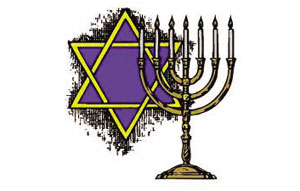The Christian Church includes not only the New Testament
(Christian scriptures) but also the Old Testament (Jewish
scriptures) in the canon of sacred literature, the Bible. Next
week, two local congregations will hold special observances
honoring their faith’s Jewish heritage.
The Christian Church includes not only the New Testament (Christian scriptures) but also the Old Testament (Jewish scriptures) in the canon of sacred literature, the Bible. Next week, two local congregations will hold special observances honoring their faith’s Jewish heritage.
The great Jewish festival of Passover, which the late columnist David Broder called “the finest of all festivals of freedom,” will occur next month.
When the Jews were suffering as slaves in Egypt, God sent Moses to lead them to freedom. Pharaoh, the Egyptian ruler, was stubborn, and it took a series of terrible plagues sent from God before he agreed to free them.
During the final plague, the Angel of Death visited Egypt, killing the first-born in every household. The Jews, though, were spared because they had applied the blood of sacrificial lambs to their doorways.
That night the angel passed over their houses. Pharaoh, seeing the vast destruction, ordered the Jews to leave his realm. They departed so quickly that their bread had no time to rise.
As a Jew, Jesus of Nazareth celebrated the Passover each year. In fact, the Gospels say that it was in Jerusalem during the Passover that he was arrested, tried and executed. On the night of his arrest, Jesus participated with his followers in a traditional Jewish “Seder.” It is that Passover meal that Christians have transformed into the ritual known variously as “Mass,” “Eucharist,” “Holy Communion” or “Lord’s Supper.”
At 11 a.m. Sunday, Rich Robinson, from Jews for Jesus, will present “Christ in the Passover” at Gilroy’s First Baptist Church (8455 Wren Ave.).
This informative demonstration of ancient Jewish customs includes the traditional items used in the Jewish celebration. But Robinson’s discussion emphasizes how the meal can be interpreted to prove that Jesus is the Messiah foretold in the Old Testament.
For example, there is a parallel between the lambs sacrificed to free the Jews in the Exodus story, the lamb shank bone placed annually on the table at the Seder and the crucifixion of Jesus as the “Lamb of God.”
Jews for Jesus has presented this program in more than 38,000 churches. Robinson will answer questions afterwards, and there will be a DVD of the presentation available. For more information, call the church at 847-6000.
Another important Jewish holiday is Purim, which celebrates the defeat of a plot to exterminate the Jews in ancient Persia. “Purim” in Hebrew means “lots” or “chance,” and refers to things happening by chance or coincidence.
The book of Esther in the Old Testament tells about a gullible king, Ahasureus, who banished his first wife for disobedience and later replaced her with Esther, a beautiful woman who (unknown to him) was Jewish.
Esther’s cousin, Mordecai, offended the king’s prime minister by refusing to bow to him at court as protocol demanded. Haman, the prime minister, vowed to get revenge for this slight by killing Mordecai and all the Jews in the kingdom. At Mordecai’s urging, Esther resolved to appeal to the king on behalf of her people, putting herself in great danger because anyone approaching the king without being summoned could be executed for this breach of etiquette.
Fortunately for Esther and the Jews, Ahasuerus was so charmed by her arrival that he forgot to punish her for barging in and offered her a reward “… even to half of my kingdom.” Esther begged him to spare the Jews from annihilation. He did. In an episode rich in irony, Haman was hanged on the very gallows he had prepared for Mordecai and the Jews.
One of the primary ways of observing Purim is to hear the reading of the book of Esther, commonly known as the “Megillah.”
This reading is accompanied by booing, hissing, stamping of feet and the shaking of “gragers” (noisemakers) whenever the name of Haman is mentioned.
This is also the occasion for a party where participants celebrate raucously the bravery of a remarkable woman who showed extreme courage in the face of danger to save the Jewish people from destruction.
The Bridge at San Martin, a Judeo-Christian congregation, will be holding its annual Purim celebration at 2 p.m. Saturday at 425 East Middle Ave. The event will include a reenactment of Ester’s story through the use of puppets, and the afternoon will continue with the enjoyment of music and food.
To reserve space at this free event call the church at 779-8169.










